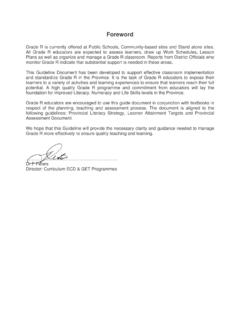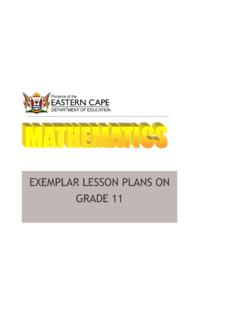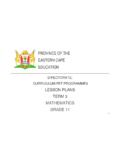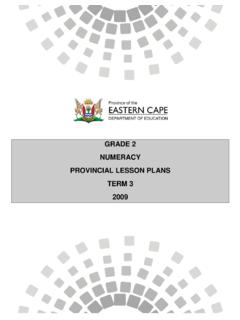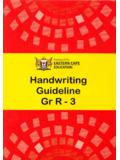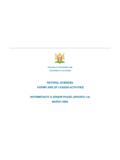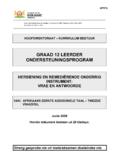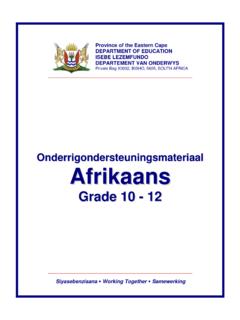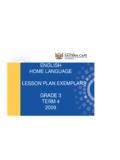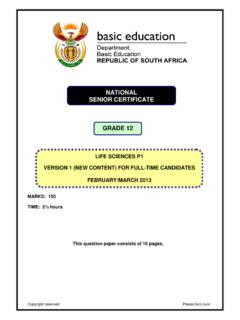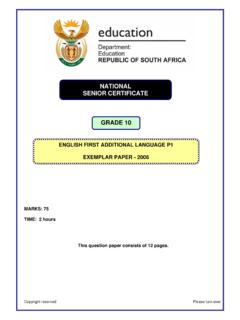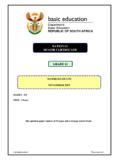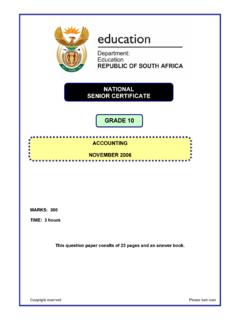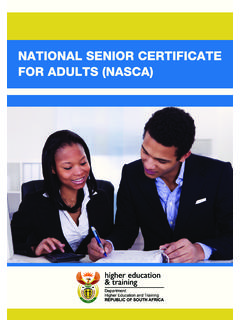Transcription of NATIONAL SENIOR CERTIFICATE GRADE 10 - Primex
1 NATIONAL . SENIOR CERTIFICATE . GRADE 10. BUSINESS STUDIES. NOVEMBER 2006. This memorandum consists of 17 pages. Copyright reserved Business Studies 2 DoE/November 2006. NSC. MEMORANDUM. SECTION A. QUESTION 1. QUESTION B. D. C. B. A 5 x 3 = (15). QUESTION FALSE - NEGATIVELY. FALSE LABOUR. TRUE. FALSE PUBLIC RELATIONS. FALSE 21. 5 x 3 = (15). QUESTION (B) Natural Resources (H) Information (D) Adaptability (A) Working (C) Private 5 x 2 = (10). [40]. SECTION B. QUESTION 2. List five (5) components of the micro business environment. 1. Vision 2. Mission 3. Objectives 4. Resources 5. Management functions or business functions. 6. Skills 7. Management tasks. 8. Immediate work environment. 9. Any other acceptable correct answers. Any 5 x 2 = (10). Copyright reserved Business Studies 3 DoE/November 2006.
2 NSC. MEMORANDUM. Read the given case study carefully and answer the questions that follow. Thandi approaches you as a business consultant to assist her in the decision of starting her new business. You advise her that market research must be conducted before finally making the decision. What information would Thandi need to start her business? (1) Nature of products or service that consumers want. (2) Other related products or services on the market that may be in competition, (3) Willingness of consumers to purchase the product or service (4) Price consumers will be prepared to pay for the product or service. (5) Quantity of the product or service they are willing to purchase. (6) Other correct possibilities. Any 4 x 2 = (8). Design a market research questionnaire that could be used by Thandi to collect information on the setting up of her new business.
3 You are required to design FIVE (5) questions that can be used in the questionnaire. (1) Will you buy products such as greeting cards, postcards or writing paper made from environmental resources? (2) Are the same or similar products sold in the immediate or nearby vicinity? (3) Do you think the paper products are sold at reasonable prices? (4) Are you willing to buy these products? (5) How many of these products are you willing to buy? (6) Other correct possibilities. Any 5 x 2 = (10). Using examples identify the components of Thandi's marketing mix. (8). (1) Product/s: per products, greeting cards, writing paper, postcards. (2) Place: Mpumalanga (3) Promotion: Brochures (4) Price: Competitive 4 x 2 = (8). Copyright reserved Business Studies 4 DoE/November 2006.
4 NSC. MEMORANDUM. Conduct a SWOT analysis for this new business venture. Strengths Weaknesses 1. Hands on business 1. Lack of sufficient capital. experience. 2. Competitors 2. Availability of resources. 3. Limited marketing and 3. Entrepreneurship. management experience and 4. Target market tourists. training. 5. Natural resources such as 4. Trained labourers for the type elephant and rhino dung of business. tourist attraction. 2 x 2 = (4). 2 x 2 = (4). Opportunities Threats 1. Tourism market. 1. Threat of competitor change 2. Very few competitors of prices, diversify product to 3. Pricing competitive use Thandi's ideas. 4. Abundance of resources. 2. New business or similar 5. Special attraction wild products to be established. animal dung 3.
5 Financing (securities not existing). 4. To be bought out by bigger businesses. 2 x 2 = (4) 2 x 2 = (4). Note: Any other acceptable correct answer. 4 x 4 = (16). Briefly describe the most important components of Thandi's business plan. 1. Vision, mission and objectives. 2. Location of premises. 3. Marketing plan. 4. Financial plan. 5. Target market 6. Future expansion. 7. Distribution plan for products. 8. Sustainability of business. 9. Any other suitable possibilities. 4 x 2 = (8). (60). Copyright reserved Business Studies 5 DoE/November 2006. NSC. MEMORANDUM. QUESTION 3. You are the manager of this company. Indicate and write down how you would make best use of time to ensure long-term success of the company. (1) Set clear goals. (2) Scheduling: Plan the year, month,week and day.
6 (3) Eliminate wasteful activities. (4) Practise key management techniques. (5) Prioritise tasks. (6) Set deadlines. (7) Use time saving devices: fast tracking, outsourcing etc. (8) Help to organise the workspace of workers. (9) Any other suitable answer. 5 x 2 = (10). In the light of the above statement discuss the most important self-management characteristics of highly successful entrepreneurs. (1) Need to be in control of yourself. Actions, thoughts and attitudes. (2) Practise self-discipline and remain self-critical. (3) Be an efficient and effective manager and leader. (4) Display attitudes and values that allows you to lead the business in a positive way. (5) Be self-confident and self-reliant. (6) Be creative and versatile. (7) Be trustworthy and dependable.
7 (8) Execute tasks accurately and carefully. (9) Be willing to commit yourself. (10) Be energetic, hardworking and creative. Any 5 x 2 = (10). Give ONE (1) example of business objectives by applying the above criteria. Business objectives must have the following characteristics SMART. S = (5) Specific Increase profits, sales or turn-over by 10%. M = (2) Measurable - Profits at the end of the current financial year. A = (7) Action Vigorous advertising in the newspaper and other media. R = (6) Realistic Top management has decided that increasing sales by 10% is a realistic objective. T = (3) Time-management Weekly, monthly report on sales to evaluate progress towards achievement of our objective. 5 x 3 = (15). Copyright reserved Business Studies 6 DoE/November 2006.
8 NSC. MEMORANDUM. Assume you are the owner of M & C General Store. Identify the problem that is experienced by the store. There is a problem with the specific canned food bought by Thulule and Smith. (3). You as the owner of M & C General store has to solve the problem. Discuss Six (6) logical steps that you will follow to solve the problem. (1) Identify the problem canned food. (2) Definition of the problem poisoned canned food. (3) Construct strategy for problem solving withdraw product from shelf & contact manufacturers. (4) Decide how to implement strategy suggestion that product should be tested and in the meanwhile not offering it for sale. (5) Allocation of resources call two customers in and offer to pay doctors expenses and free alternative product.
9 (6) Monitor problem solving progress report from manufacturer. Press release. (7) Evaluate problem solving successful or not. Did you manage to change customers perception about your store? Any 6 x 2 = (12). Explain FIVE (5) criteria for successful and collaborative team performance in a business. (1) People in the team must be prepared to work together. (2) Objectives of the team must be formulated carefully. (3) Each member must know his/her role within the group. (4) Each member must have a skill, experience or quality that adds value to the team. (5) Team members must support each other. (6) Team members must have team spirit, trust and be participative. (7) Openness and expression of ideas. (8) Good decision-making skills. (9) Review of the team process.
10 (10) Team members must be innovative and creative to solve problems. 5 x 2 = (10). (60). Copyright reserved Business Studies 7 DoE/November 2006. NSC. MEMORANDUM. QUESTION 4. Discuss any FIVE (5) business functions. (1) Marketing (a) Responsible for the pricing, distribution and marketing of the product. (b) Ensure the correct marketing mix to boost sales. (c) Transfer of the goods and services from producer/manufacturer to the consumer. (2) Human Resources (a) Employment of skilled and unskilled labour. (b) Training schedules to up-skill workers. (c) Appointment, maintenance of human resources (3) Production (a) Ensure quality products are manufactured. (b) Transformation of raw materials into finished products. (4) Administration (a) Structuring of activities through administration imperative.
